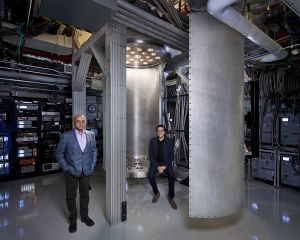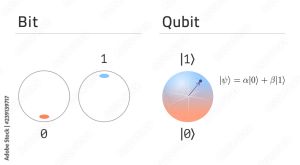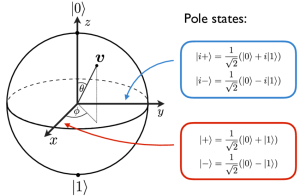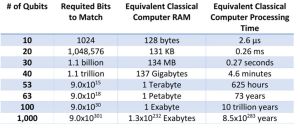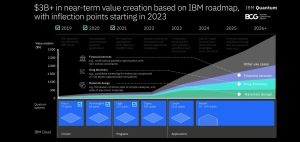Difference between revisions of "Darwin2049/ChatGPT4/PhaseShift"
Darwin2049 (talk | contribs) |
Darwin2049 (talk | contribs) |
||
| Line 37: | Line 37: | ||
[[File:QU-BIT04.jpg|300px|right|Binary vs. Quantum Logic]] | [[File:QU-BIT04.jpg|300px|right|Binary vs. Quantum Logic]] | ||
[[File:BlochSphere00.png|300px|right|Bloch Sphere]] | [[File:BlochSphere00.png|300px|right|Bloch Sphere]] | ||
[[File:IBM-TRUENORTH. | [[File:IBM-TRUENORTH.jpg|300px|right|IBM TrueNorth Neuromorphic Processor]] | ||
'''''<Span Style="COLOR:BLUE; BACKGROUND:SILVER">Quantum Computing.</SPAN>''''' Quantum computing is currently making its way into the mainstream computing world. Major industrial giants such as IBM, Google and other smaller entrants such as D-Wave are moving forward briskly at ushering this new technology into the light of day.<BR /> | '''''<Span Style="COLOR:BLUE; BACKGROUND:SILVER">Quantum Computing.</SPAN>''''' Quantum computing is currently making its way into the mainstream computing world. Major industrial giants such as IBM, Google and other smaller entrants such as D-Wave are moving forward briskly at ushering this new technology into the light of day.<BR /> | ||
Recently IBM announced its IBM Quantum System Two which is based upon their 432 qubit Osprey quantum processor. Google has published a timeline of progress stipulating increasing performance milestones through the 2020’s. Some salient points to keep in mind regarding this topic are that: | Recently IBM announced its IBM Quantum System Two which is based upon their 432 qubit Osprey quantum processor. Google has published a timeline of progress stipulating increasing performance milestones through the 2020’s. Some salient points to keep in mind regarding this topic are that: | ||
Revision as of 19:10, 5 December 2023
Quantum Computing. Quantum computing is currently making its way into the mainstream computing world. Major industrial giants such as IBM, Google and other smaller entrants such as D-Wave are moving forward briskly at ushering this new technology into the light of day.
Recently IBM announced its IBM Quantum System Two which is based upon their 432 qubit Osprey quantum processor. Google has published a timeline of progress stipulating increasing performance milestones through the 2020’s. Some salient points to keep in mind regarding this topic are that:
- Before/After. Quantum computing will be transformative in all areas of human endeavor. Impacts will emerge that are comparable to the taming of fire, animal husbandry, agriculture and writing.
- Cognitive Prosthetic. Increasingly mainstream quantum computing systems will enable dramatic advances in science and technology. Associated advances will emerge in other areas of human endeavor such as politics, sociology, psychology, economics and geopolitics. An tentative model might be a person with a cognitive expansion capability. This might resemble something like an actively directable form of sub consciousness.
- Composite Systems. Typical high end systems today consist of rows of rack mounted processing systems that are interfaced together for enhanced performance. IBM has publicized that its Quantum System Two will function as an element in a hybrid ensemble. An environment with several dedicated systems will offer novel and unexpected capabilities to users.
- Conformal Cognitive Interfaces. Combining a deep learning based system with optimized user interface systems that excel at voice and video presentation will result in systems that will provide users the experience of interacting with the most knowledgeable people on the planet. These avatar based presentations will be indistinguishable from real people. Calibrating their behavioral traits to make their presentations more human-like will mean that the need for a revision of the Turing Test will become necessary. By way of example early fictitious presentations as well as recent scientific and engineering developments suggests this will become the common reality. Why might this be so?:
- HAL9000. The 1968 movie, a computing system known as the HAL9000 system exhibited behavior that might convince an informed observer that it was conscious. Developments during the course of the movie made clear that it had intentionality and goal seeking behavior. Given today's climate that cautions against alignment risks the HAL9000 system clearly demonstrated that this had been a missing behavioral feature in HAL9000's development. With lethal results. That being so, the movie made ground breaking predictions insofar as HAL9000 was capable of interacting with human via speech. It possessed acute visual and spatial abilities. Moreover and crucially it clearly demonstrated theory of mind. This became evident as it executed a plan of deception. This was made clear when it formulated a plan to mislead the crew and cause them to believe that a crucial component failure had actually happened.
- Sphere. This Michael Crichton novel (which later became a movie) powerfully presented the concept of a cognitive prosthetic that was capable of materializing objects based upon the wishes or desires of a user. A key element in the novel offered the supposition that at some point an advanced extra terrestrial civilization might create technology that can materialize whatever a user could envision. Ultimately the sphere could be considered a cognitive echo chamber. But one with the ability to materialize the users thoughts or wishes. Like HAL9000 it too exhibited no signs of alignment. Rather it was presented as just another tool to be used much as hammers or screw drivers are considered to be merely tools and have no intrinsic means of enforcing any kind of moral or ethical alignment values upon their usages. It exhibited none of the traits associated with consciousness such as sentience, goal oriented behavior, intentionality or consciousness.
- CG4/Watson/TrueNorth (IBM). The IBM corporation has a technology imperative of creating electronic versions of massive neural networks. The current state of play can be seen with the IBM TrueNorth processor. This is a neuromorphic device that mimics the neurological activity of significant swathes of the mammalian cortex. Incorporating this technology into an ensemble of processing elements means that the new systems that will emerge will possess capabilities that rival or even dwarf those of the best humans, animals or combinations thereof.
- Geostrategic Imperatives. The national interest security community has forcefully sounded the alarm about the existential importance of seizing the scientific and technological high ground in the area of quantum computing and artificial intelligence. Going forward the race will escalate between the US and the PRC. Calls to slow or pause advances in deep learning systems will be dismissed as suicidality naïve and shortsighted.
Phase Shift: Gas, Liquid, Solid. Classical physics describes how states of matter possess different properties depending upon their energy state or environment. Thus on the surface of the earth at sea level we experience the atmosphere as an odorless, colorless, tasteless gas. In an environment above the freezing point of water we are unaware of the fact that we inhale and exhale atmospheric gas. It is odorless, colorless and tasteless. Therefore it is difficult if not impossible to imagine that it can condense into a clear liquid.
The previous gaseous or liquid states of water vapor do not prepare us to see solid objects made from this same material.
Looking forward we should expect to encounter very similar kinds of different experiences, i.e. a prior state offers no preparation for encountering a subsequent one.
Transitioning to quantum computing will frequently involve the same kinds of jarring discontinuities. Informed observers have reported that Chat GPT4 required roughly ninety to one hundred days to train using 25000 high end Nvidia GPU devices. This time collapse to minutes or less.
When new knowledge can be incorporated into a quantum based deep learning system on almost a moment’s notice then it suggests that the incorporation of new knowledge on any topic can be almost instantly brought to bear on any problem.
Chat GPT4 allows the user to perform fine tuning for their specific purposes. This suggests that we may see an entirely new ecology arise in very short periods of time. It may be liken transitioning from submitting batch jobs on decks of punched cards to ultra high resolution virtual reality in one step.
The upshot will be that problem that no one has yet even imagined will become soluble in breathtakingly short periods of time.
Working from the premise that new knowledge can be rapidly incorporated into a deep learning system and then fine tuned to specific needs suggests that the entire landscape as it is now known is about to undergo a dramatic shift. By way of a leap of imagination we might see a number of out of date notions reincarnate themselves. By way of imagining just a few:
- Cambrian Explosion.
- Perpetually Morphing Ecology.
- Alchemists, Sorcerers, Magicians, Wizards, Apprentices, Jesters.
- Spirits.
- Oracles.
- Clergy.
- Philosophes.
- Orthodoxy, Heterodox, Heretics, Revisionists, Protestants, Orcs.
- Cardinals, Bishops, Prelates, High Priests.
- Guilds.
- Smiths, Masons, Wheelwrights, Coopers.
- Balloonists.
- Navigators.
- Gatekeepers.
- Tamers, Trainers.
- Mentats.
- Samurai, Ninjas, Ronin.
- Katsas, Kidon, Sayanim.
- Pied Pipers, Horse Whisperers, Snake Charmers, Jugglers, Chanteuses.
- The Krell.
Quantum Mechanics. The brief items that follow are deliberately kept brief because a discussion of the mathematics and physics underpinning quantum computing is beyond the scope of this discussion. This is because the topic area obliged a deep understanding and conversance with very advanced mathematics and physics.
Quantum computing mechanisms due to their inherent nature are capable of solving problems that are beyond any current or foreseeable classical computing architecture.
There are various reasons why this is the case. Quantum computing as the name suggests is grounded in the quantum world. Understanding quantum physics requires the most advanced grounding in physics and mathematics. Therefore we provide only a cursory introduction to some of the more basic elements. Additional definitions can be found via the link at the end of this page.
Advanced mathematics is advised for those wishing to further understand the crucial elements of entanglement, coherence, vector spaces or quantum algorithms.
What can be said currently however is that this new computational environment will make possible solution to currently intractable problems soluble within acceptable time frames. The ability to do so will invariably carry with it great promise but also great risk.
- Superposition. Quantum computers are capable of performing calculations that are beyond the scope of classical computing devices. This arises from the quantum reality of superposition. This means that an object at the quantum level has two factors that can be measured: momentum and location. At any instant a quantum system can be in all possible definable states. The act of attempting a measurement will result in the collapse of this superposition state and result in returning a specific value. But this also means that only one factor can be known at the moment of measurement EITHER the position of the object or its momentum - but not both. This arises due to the Heisenberg's Uncertainty Principle.
- Coherence/Decoherence. A crucial factor that conditions the utility of a device operating at the quantum level is noise. Any kind of noise from heat, vibration or cosmic rays can disrupt the extremely delicate processes at the quantum level. Therefore when numbers are presented they are often not well differentiated into qubits that can perform useful computations relative to those that do not. A strategy for dealing with this problem has been to use large numbers of qubits as an error correcting means. Therefore when a quantum device is said to consist of over a thousand qubits then in fact it might have to use 90% of them just for maintaining quantum coherence and entanglement. In order to get meaningful results these quantum states must be maintained for the duration of the calculation. But at these levels and using this means the result is that calculations happen at scales far beyond merely electronic or even photonic speed but due to quantum realities multiple evaluations can happen in parallel. The result has been the dramatic speed up numbers that have recently been reported in various research labs and corporations. Therefore a quantum computer that is claiming to have one hundred or more coherent qubit capability means that they can outperform classical computers by very wide margins.
- Entanglement.
- Wave-Particle Duality.
- Heisenberg's Uncertainty Principle. Werner Heisenberg was the developer of the now famous Heisenberg Uncertainty Principle and won the Nobel prize for his discovery in 1927. His principle essentially stated that at the micro level of reality (i.e. atomic or subatomic) one can only measure the position OR the momentum of a particle. But because of the particle/wave duality nature of all matter it is impossible to measure both. Should we attempt to pinpoint the location of a particle we might discover its precise point at a specific moment in time but we can NOT know its momentum. Conversely we might measure its momentum or energy state but we can NOT know its position. The reality of the world at the quantum level is inherently counterintuitive. However innumerable physics experiments have demonstrated beyond doubt that this is the reality in which all material objects exist.
The interested observer can find a number of useful references addressing the topics of quantum bits, entanglement and superposition
In some cases they will prove to be fairly technical.
